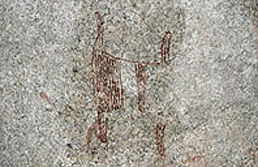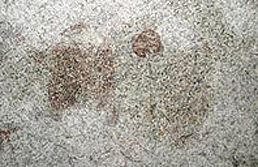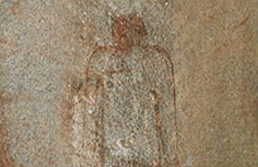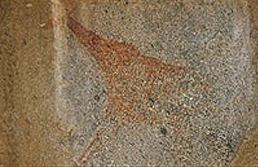 |
 |
Ntwiga 3 |
Site 22 |
Singida Region / Iramba District / Kinyangiri Division
On the northwestern slopes of Ntwiga ridge are several grano-dioritic inselbergs, one of which has pictographs. They are protected from rain and direct sun by a huge overhang.The subject matter consists of naturalistic silhouettes of animals chiefly antelopes and bovids, stylised anthropomorphic figures and geometrics. Three shades of ocherous red, deep, medium and light, seem to have been used, but no order of superpositioning was detected. There are also representations of what are believed to be ethnographic objects, very similar to the present day grain storage containers made by the local inhabitants from saplings. In terms of style, the animals are executed in the naturalistic single line outline as well as in the boldly washed silhouettes. Among the animals are an elephant rendered in the open line outline style, a hartebeest depicted alongside a man holding a bow and three other animals, painted in such a way as to deliberately omit the front part of the animal. This is a style, which has been observed not only in several sites in the Singida-Iramba area, but also in the better-known rock art area of Kondoa. Presumably it has ritualistic or symbolic meaning, which the author has not yet been able to discover.
From the point of view of visual interpretation, one activity pattern seems to stand out. This is a hunting scene represented by a schematized human figure holding a bow while an animal runs away. Another scene involves the anthropomorphic figures in body contact suggesting dancing, or perhaps as some crew members intimated, copulation., but which on a closer look is more like dancing. The geometrics include circles, lines, crosses, etc. We can only surmise that some of the portrayals, especially the unidentified ethnographic objects and the crosses which are of the same pigment, are historical and perhaps mark the introduction of Christianity in the area just like the painting of a locomotive in a site in Sanga Mwadifu, perhaps marks the time when the railway reached Singida. Whatever the meaning, the site is in good state of preservation and will hopefully remain so for some time so that it can be studied further.
 |
 |
Sanga Mwadifu - Unyambwa 1 |
Site 23 |
Singida / Singida District / Sanga Division
The site is a straightfaced rock shelter in the midst of several inselbergs in the Unyambwa plains facing north. It is easily reached from Unyambwa primary school.The subject matter includes animals, anthropomorphic figures, a locomotive engine, unidentified objects and doodlings, all in black, overlying earlier paintings done in red pigment. Included in the animals are domesticates such as dogs, sheep, and perhaps cats.
Obviously part if not all of the subject matter is historical. However, in 1995, an old villager of about 65 years old denied knowledge of the time of the paintings, but I think he was withholding the information for reasons which may have something to do with the ritualistic significance associated with rock art sites. It can, for instance be argued that there are very good chances that the painting of the locomotive engine was executed in 1946 or shortly after, for that is the time when the railway reached Singida town, some 15m from the site. By inference therefore, all the other paintings in the same style and pigment (black), must be contemporary with the picture of the locomotive. By the same argument, the representations executed in ocherous red and overlain by the black pictographs must have been painted before 1946.
Further investigation revealed that some of the paintings were the work of one villager whose name is represented by some letters, which are difficult to make out. This information was volunteered by young people, some of whom had graduated from the nearby primary school a year before. It is necessary to check this information with elders before it can be accepted as being a true account of the paintings. The area around is littered with lithics some of which are artifacts. The state of preservation is reasonably good.
 |
 |
Sanga Mwadifu - Unyambwa 2 |
Site 24 |
Singida / Singida District / Sanga Division
In the same area as Unyambwa 1 is another site, which will be referred to as Unyambwa 2. However, unlike the previous one, the pictographs are depicted in one style, i.e. naturalistic silhouettes and also in one pigment; a bright ocherous red. The subject matter includes animals such as giraffe, eland, etc. Humans are also depicted.
→
Rock Art in Tanzania
→
Tanzania Rock Art - Forward by Dr. Meave Leakey
→
Overview of Tanzania Rock Art Sites
→
Tanzania Conservation & Management
→
Tanzania Rock Art Sites|
1-2 |
3-6 |
7-9 |
10-12 |
13-14 |
15-16 |
17-18 |
19-21 |
22-24 |
25-26 |
→
Africa Rock Art Archive
→
Bradshaw Foundation
Like us on Facebook & Follow us on Twitter to receive news & updates:












